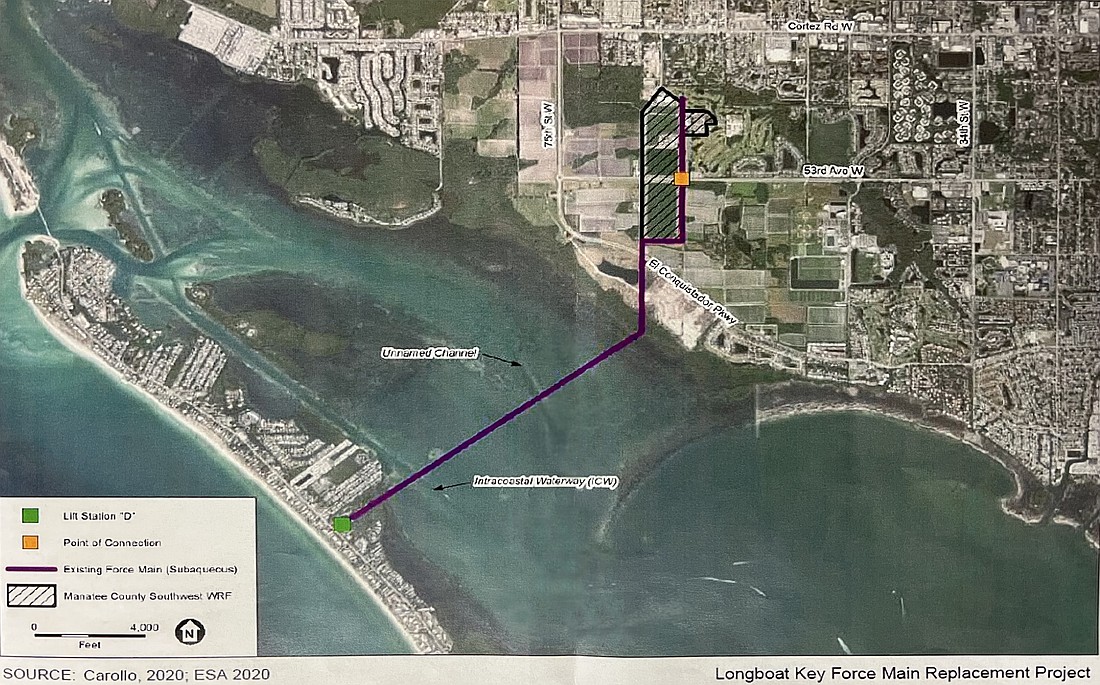- April 29, 2025
-
-
Loading

Loading

The latest estimate for replacing Longboat Key’s subaqueous force main — one of the largest upcoming projects for the town — came with an estimated increase of about $8 million.
According to estimates from two private consultants, the cost of the project went from about $21.9 million to about $30 million.
“It’s not that it’s gone out to bid, but the market has changed dramatically,” Town Manager Howard Tipton told commissioners at the April 15 strategic planning retreat.
The new number takes into consideration construction and construction administration costs. Between the two consultants, the higher estimate was $28.7 million. Director of Public Works Isaac Brownman said staff went with the higher estimate to be conservative with rate assessments.
He also told commissioners on April 15 that some of his peers estimated the project would be $35 million to $40 million, so a $30 million estimate sounded pretty good.
“We still need to negotiate easements with Long Bar, and so by just rounding, $30 million is probably a fair number to do a new rate assessment on,” Brownman said.
The project would replace the force main that is underneath Sarasota Bay and leads from Longboat Key to the mainland. Permitting was already acquired for the project from the Florida Department of Environmental Protection and the United States Army Corps of Engineers.
Another cost increase came for the Country Club Shores asbestos cement pipe replacement as well, Tipton informed commissioners.
“Between the subaqueous and Country Club Shores, we’ll be issuing debt that will be paid back with utility revenues,” he told commissioners at the planning retreat.
For the subaqueous project, the town has $6.8 million already secured.
Of that, $1.8 million is a general fund transfer of some of the town’s funds available through the American Rescue Plan Act. A 2023 Omnibus Community Grant Program sponsored by U.S. Rep. Vern Buchanan adds another $3 million, and a state appropriation provides $2 million.
That still leaves about $20.8 million to $23.9 million that the town needs to head into construction.
Tipton said that staff hopes to pull in some grants for this project. Another opportunity could be to ask Manatee County for some assistance.
“That seems, to me, like one that we could make a pretty strong pitch to Manatee (County) to participate in,” Mayor Ken Schneier said about the project.
But most likely, the town will need to go into debt for the project.
“The biggest way that we’re paying for it is through the rates that our users pay, which is typically how utility work gets done,” Tipton said.
In 2021, the town approved utility rate increases of 5% each year. There are still two more years on that plan, so residents’ water bills would increase by 5% each year for the next two years. The rates would not roll back at the end of the program.
Tipton said staff needs to evaluate if these increases will be enough to cover what they now know.
In the meantime, he told commissioners that the town can utilize utility fund reserves and short-term financing, then issue long-term bonds when feasible.
In June 2020, a leak in the old pipeline caused by corrosion was discovered. The break in the pipe was about 22 square inches. The leak caused an estimated 14 million gallons of effluent to leak into the bay, which led to fees of more than $440,000 for the town.
The subaqueous replacement project was originally split into two parts. First was the mainland portion, which began construction in November 2022.
For that project, about 1.2 miles of the old pipeline was relined with new, upgraded material that was estimated to last between 75 to 100 years. The relining went from the leak point, about 400 feet north of Sarasota Bay, to the Manatee County meter.
The town opted to slip-line new pipe into the old pipe. That meant installing a new pipe, about 18 inches in diameter, into the old pipe, which was about 20 inches in diameter.
Construction wrapped up in May 2023 and the mainland portion was operational.
That portion of the project cost about $2.6 million, $2 million of which was funded by state appropriations.